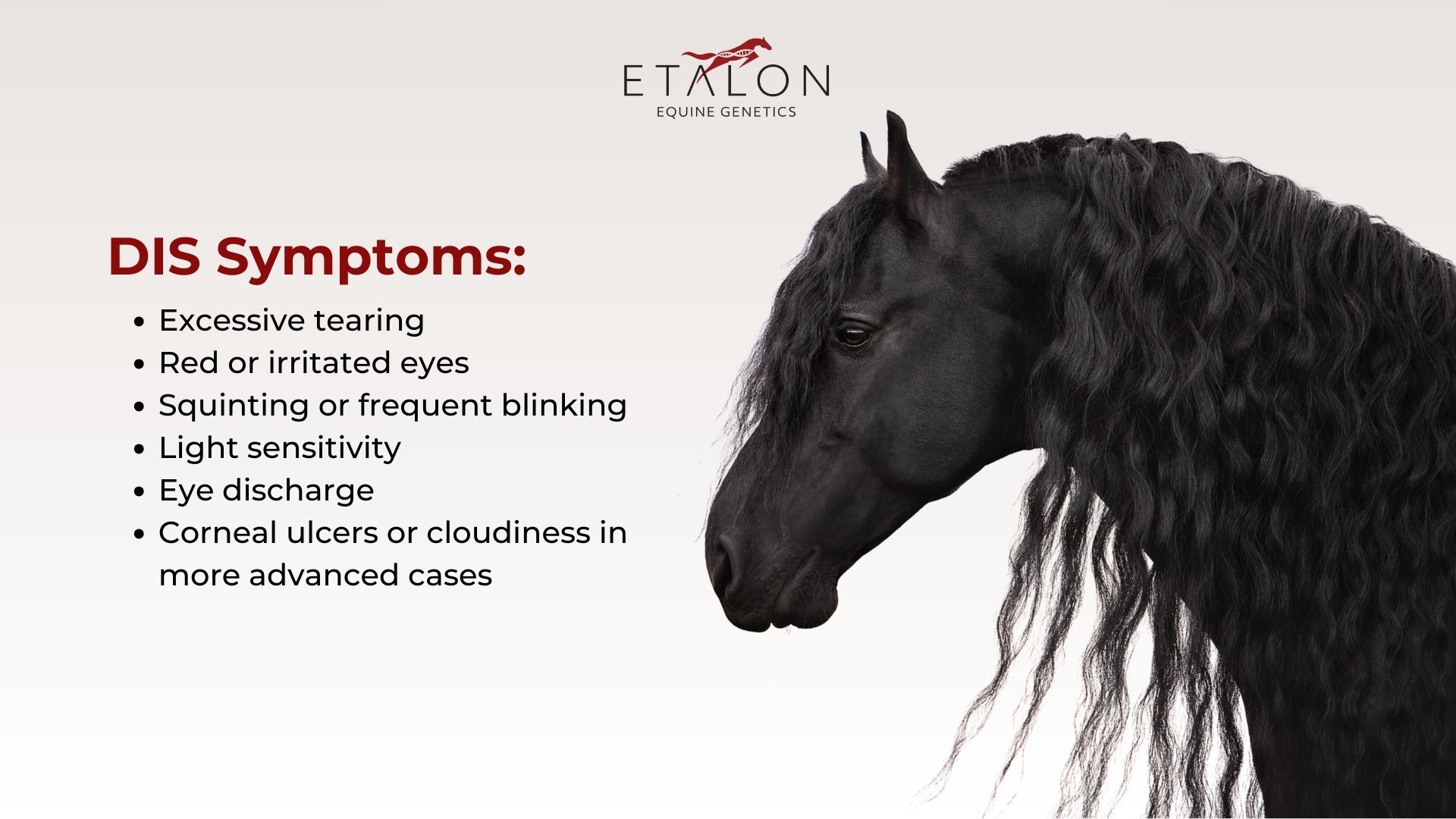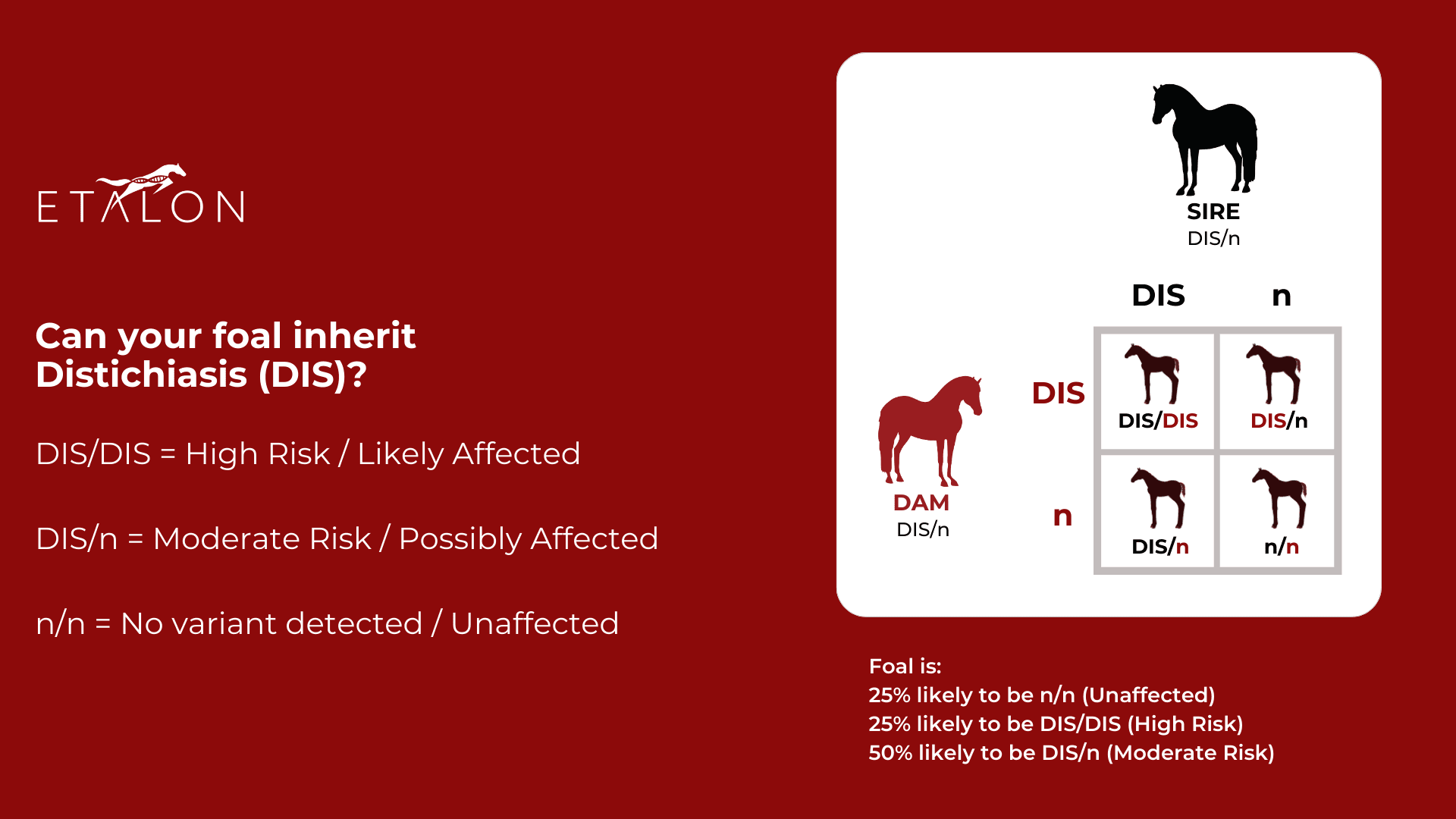Genetic Health Risks: Distichiasis (DIS)
August 21, 2025
When it comes to your horse's health, their eyelashes might not be the first thing on your mind, but that certainly doesn't mean they should be overlooked! A 2020 study identified a genetic variant associated with an inherited eyelash disorder, particularly in Friesian horses, known as distichiasis.1 In horses with distichiasis, extra eyelashes grow from where they shouldn't and can rub against the surface of the eye. This often causes irritation, discomfort, and, in some cases, vision problems. Discovering the genetic connection to this condition is a significant step toward a better understanding and long-term management of it.
Key Takeaways
- Distichiasis is a disorder where abnormal eyelashes grow from the eyelid margin, often irritating the cornea.
- Symptoms may include tearing, squinting, inflammation, or corneal ulcers.
- A genetic variant has been linked to the condition and is believed to affect regulatory elements between two genes involved in tissue growth and maintenance.
- Genetic testing can identify affected horses and carriers, supporting breeding decisions and facilitating early intervention.
What is Distichiasis?
Distichiasis is a congenital condition in which extra eyelashes, called distichia, grow from the openings of the meibomian glands along the eyelid margin. These glands normally secrete lipids that form the outermost layer of the tear film, helping to lubricate and protect the eye. In horses with distichiasis, eyelash follicles develop within the gland openings rather than below them. The resulting lashes may be fine and lightly pigmented or thick, coarse, and abrasive. Because they often point inward toward the eye, they can rub against the cornea, causing irritation or damage. While some horses may show no visible symptoms, others can develop chronic discomfort or secondary issues, such as corneal ulcers, if the condition is left untreated.

Symptoms of Distichiasis
The clinical signs of distichiasis depend on the number, stiffness, and position of the abnormal lashes.
**Symptoms may include: **
- Excessive tearing
- Red or irritated eyes
- Squinting or frequent blinking
- Light sensitivity
- Eye discharge
- Corneal ulcers or cloudiness in more advanced cases
Some horses may remain asymptomatic, especially if the lashes are sparse and soft, while others may require treatment to avoid chronic discomfort.
Diagnosis
A veterinarian can diagnose distichiasis through a thorough ophthalmic examination. Magnification and specialized lighting help identify the tiny lashes growing from the meibomian gland openings. Fluorescein staining may be used to detect corneal damage.
Treatment
Treatment options depend on the severity and may include:
- Manual removal of lashes (temporary relief)
- Cryotherapy to destroy the hair follicles
- Electroepilation (electric current to eliminate lash roots)
- Surgical removal in more severe or recurring cases
Early diagnosis and management help prevent secondary issues, such as infection or long-term corneal scarring.
Genetic Risk Factors for Distichiasis
The 2020 BMC Genomics study identified a 16-kilobase (kb) deletion on equine chromosome 13 (ECA13:g.178714_195130del) associated with distichiasis in Friesian horses. This deletion is located between the two genes FAM20C and PDGFA and is likely to affect a regulatory region of the genome. Although the precise biological mechanism is still under investigation, this deletion is thought to disrupt normal gene regulation during eyelid development.
Distichiasis has also been identified in other breeds, but the relationship between the same deletion and clinical symptoms remains unclear outside of Friesians. Further research is needed to determine both the prevalence and the expression of the trait in non-Friesian populations.
Genetic Testing for Distichiasis
Etalon Equine Genetics offers a genetic test to detect the distichiasis-associated variant. Understanding a horse's genetic status can help guide breeding decisions and help owners monitor their horses for any potential clinical signs.
**dis/dis = Homozygous for the deletion. Increased likelihood of expressing the trait. dis/n = Heterozygous. Carrier of the deletion but typically not symptomatic. n/n = No variant detected. Unlikely to pass on or express the condition. **
Testing is particularly valuable for Friesian breeders and anyone with a horse showing signs of eye discomfort.

Prognosis
With early diagnosis and appropriate treatment, the prognosis for horses with distichiasis is generally good. Many cases are manageable with regular veterinary care. Severe or recurring cases may require more complex procedures, but they still tend to have favorable outcomes with proper treatment.
Prevention
There is no known way to prevent distichiasis from developing in horses that are genetically predisposed. However, genetic testing is a powerful preventive tool in breeding programs. Ultimately, the only way to prevent distichiasis is by avoiding the mating of two carriers, which reduces the risk of producing foals homozygous for the deletion and potentially affected by the condition.
Conclusion
Distichiasis may be relatively rare, but for horses that have it, the consequences can be irritating at best and vision-threatening at worst. Thanks to recent genetic research, we now have a clearer understanding of the cause in Friesians and a reliable way to test for the associated variant.
Whether you're a breeder aiming to improve your herd's health or an owner seeking answers for your heart horse, our Pro Package 2.0 includes the distichiasis (DIS) DNA test, providing clarity, insight, and what we all want – peace of mind.
Shop Pro Package 2.0 Here
References
1 Hisey, E.A., Hermans, H., Lounsberry, Z.T. et al. Whole genome sequencing identified a 16 kilobase deletion on ECA13 associated with distichiasis in Friesian horses. BMC Genomics 21, 848 (2020). https://doi.org/10.1186/s12864-020-07265-8
News & Media
Protect Your Horse with Genetic Testing for West Nile Virus Risk (WNVR)
West Nile Virus (WNV) continues to pose a serious threat to horses across the United States as the USDA reports showed a +205% total increase in Equine West Nile Virus cases during September! Protect Your Horse with Genetic Testing.
Updated Phenotypical and Genetic Assumptions for Roan Horses
Updated Phenotypical and Genetic Assumptions for Roan Horses. Etalon partners with the American Roan Horse Association.
How to Dual Register Your AQHA Horse with APHA
Genetic testing can uncover white genes to help your horse qualify for dual registration with APHA & AQHA for additional earning, competition, and breeding opportunities.
Podcast Episodes
From Hoofbeats to Healing: Veterans and Mustangs
Genetics Unbridled Podcast | Ep. 10
What if there was a way to bridge the gap between military veterans and their civilian lives using the unlikeliest of companions—wild mustangs? Or a w...
Press Releases
Etalon Equine Genetics Discovers Three New White Marking Variants in a New Gene
March 20, 2024
Menlo Park, CA - Etalon Equine Genetics has made another landmark discovery in the field of equine genetics. For the first time in 10 years, a new genetic region for color has been found!
Read MoreEtalon Equine Genetics Discovers New Novel White Variant in Pura Raza Española Horses
December 23, 2023
Menlo Park, CA - Etalon Equine Genetics, a leading provider of equine DNA testing services, has made an exciting breakthrough in equine genetics.
Read MoreAPHA Approves New White Marking Variant W35 “Holiday” in Horses Discovered by Etalon Equine Genetics
December 23, 2023
Menlo Park, CA - Etalon Equine Genetics, a leading provider of DNA testing services, has made another novel discovery in the field of equine genetics. The company has identified a new white marking variant now designated as W35.
Read More